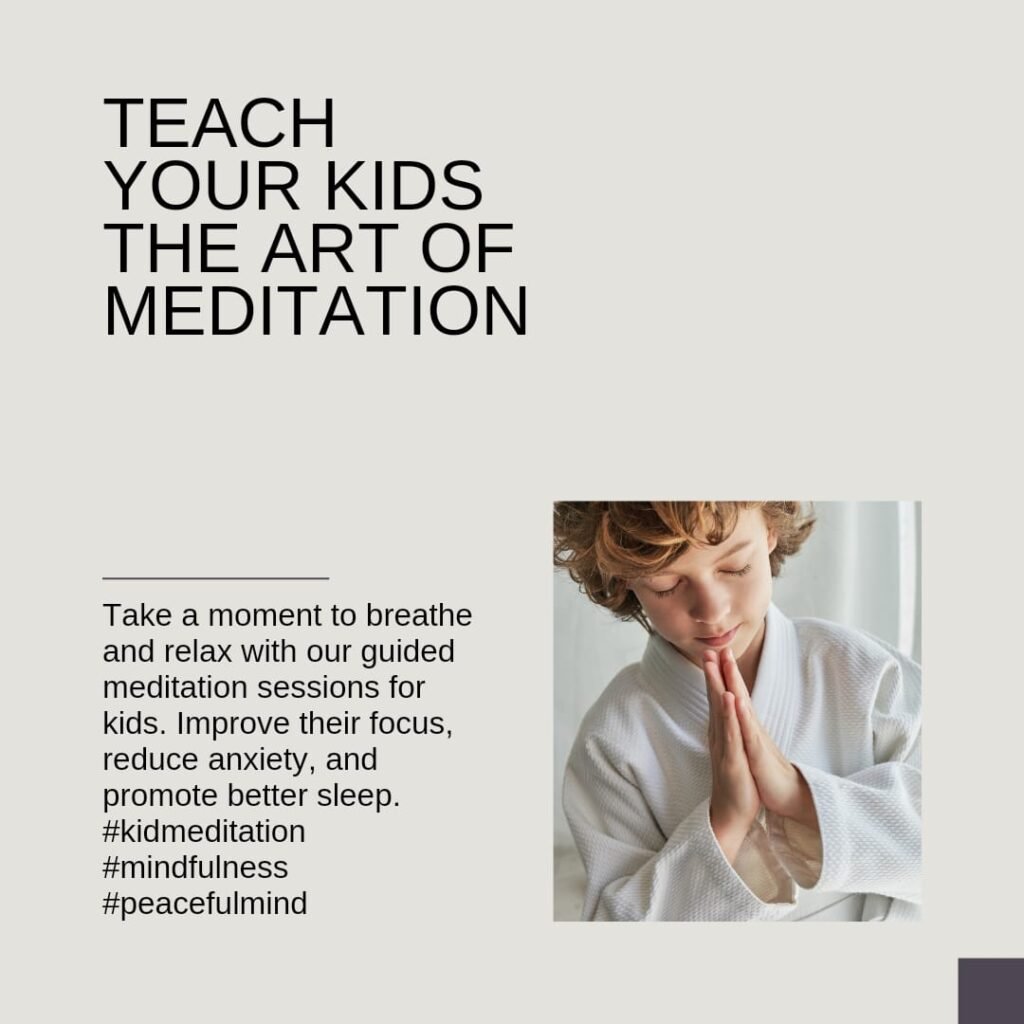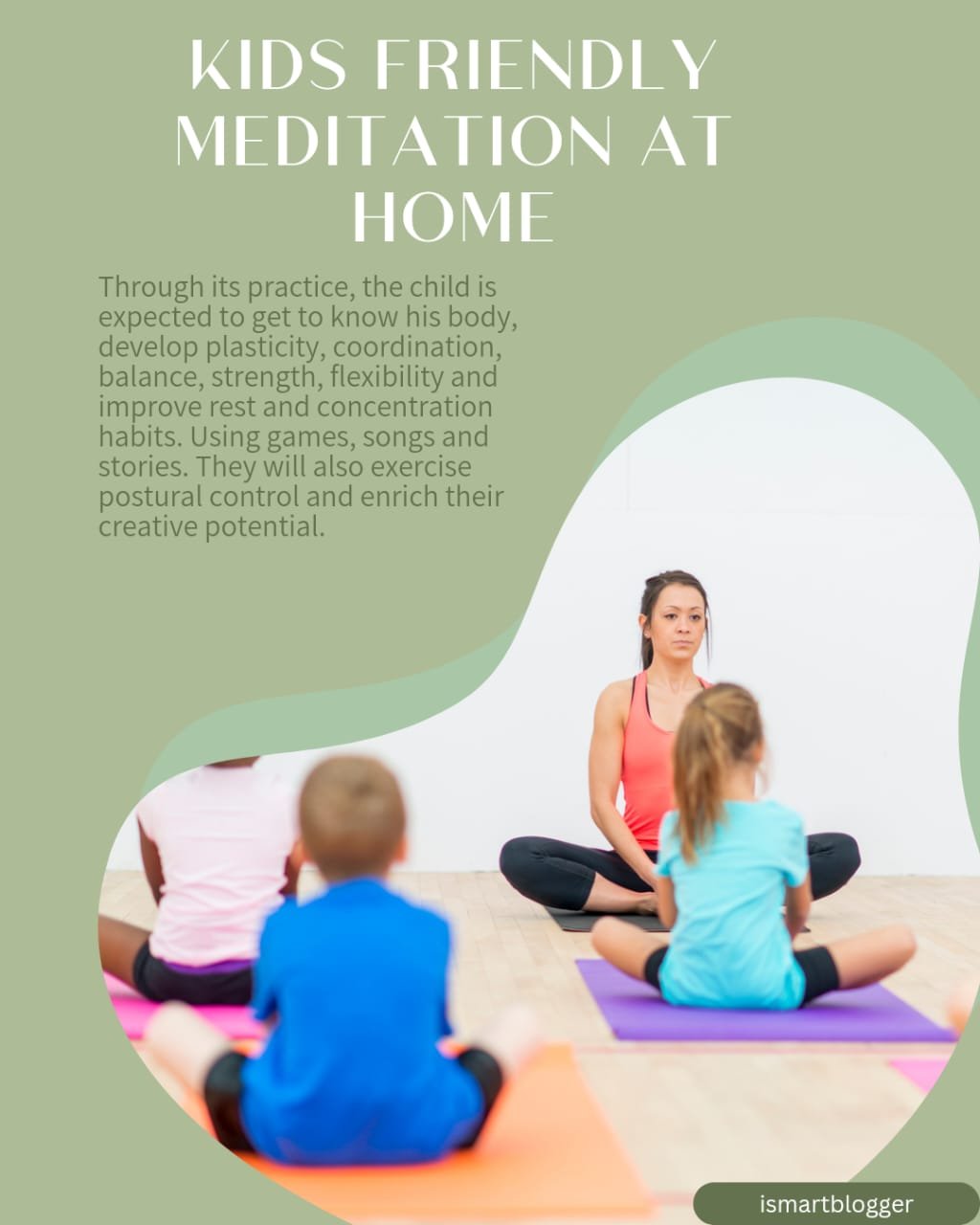Introduction
Welcome to this comprehensive guide on how to create a kid-friendly meditation space at home. In our fast-paced and often overwhelming world, meditation has emerged as a powerful tool for promoting calmness, focus, and emotional well-being in both adults and children alike.
While meditation may seem like a practice reserved for adults, it is equally beneficial for kids, helping them navigate stressors, build resilience, and enhance their overall mental health. Meditation offers numerous benefits for children.
Firstly, it helps them develop self-awareness by encouraging them to pay attention to their thoughts, emotions, and bodily sensations. This heightened awareness allows children to better understand themselves and make conscious choices in their lives.
Additionally, practicing meditation can enhance concentration and focus in children, enabling them to excel academically and perform better in various activities. Creating a dedicated meditation space at home holds immense importance when it comes to fostering regular meditation practice for children.
Just like adults benefit from having a designated space for quiet reflection and introspection, kids also need an environment that supports relaxation and encourages the exploration of their inner world. A dedicated space not only provides physical comfort but also serves as a visual reminder of the value placed on mindfulness within the household.

Understanding the Basics of Meditation for Kids
An Oasis of Inner Peace: Exploring the Essence of Meditation
Meditation, in its essence, is a practice that cultivates mindfulness, relaxation, and inner peace. It involves focusing one’s attention and calming the mind to achieve a state of heightened awareness and tranquility.
However, when it comes to children, meditation takes on a slightly different form. While the fundamentals remain the same, it is essential to adapt the practice to suit their unique needs and developmental stages.
A Mindful Journey Unveiled: How Children Experience Meditation
Unlike adults who may seek meditation as a tool for stress reduction or self-discovery, children often explore meditation more organically. For them, it can be an opportunity to connect with their inner selves and enhance concentration and emotional regulation abilities while embracing moments of stillness amidst their active lives. Children are naturally curious and imaginative creatures; therefore, incorporating elements of playfulness and creativity into their meditation practice can make it more engaging and enjoyable.
Nurturing Young Minds: Age-Appropriate Techniques and Practices
When introducing children to meditation, it is crucial to consider age-appropriate techniques that resonate with them. For younger children (ages 4-7), simple breathing exercises can serve as a gentle introduction to mindfulness. Engaging them in activities such as “balloon breaths” or “butterfly breaths” where they visualize inhaling deeply like blowing up a balloon or fluttering butterfly wings can help foster focus and calmness.
As children grow older (ages 8-12), guided visualizations become effective tools for capturing their imagination during meditation sessions. Encouraging them to visualize serene environments like peaceful meadows or colorful gardens while engaging all senses helps transport them into a tranquil state of mind.
For teenagers (ages 13 and above), incorporating mindfulness into daily activities can be more impactful. Encouraging them to practice mindful eating, walking, or even drawing can help instill a sense of presence and self-awareness.
By understanding the basics of meditation for kids, we lay the foundation for creating an ideal kid-friendly meditation space at home. Through tailored techniques and practices, children can embark on their unique mindfulness journey while reaping the countless benefits it offers.
Selecting the Perfect Location
Importance of finding a quiet and peaceful area in the house
When creating a kid-friendly meditation space at home, choosing the right location is paramount. It is important to find an area that offers tranquility and peace, away from distractions and noise.
The benefits of meditation are maximized when children can fully immerse themselves in a serene environment. Look for a space that is secluded from the main living areas, such as a spare room or a cozy corner in their bedroom.
Consideration of natural light, ventilation, and proximity to nature
Natural light can greatly enhance the ambiance of a meditation space and create a soothing atmosphere. Look for a location with windows that allow ample sunlight to enter during the day. Sunlight not only uplifts mood but also provides warmth and positive energy.
However, be mindful of excessive glare or direct sunlight that may cause discomfort during meditation. In addition to natural light, adequate ventilation is crucial for maintaining fresh air flow within the meditation space.
Proper ventilation contributes to improved air quality, which helps create an optimal environment for relaxation and focus. When possible, consider selecting a location close to nature or with views of greenery outside.
Connecting with nature has been shown to have numerous therapeutic benefits and can aid in promoting deep relaxation during meditation sessions. By carefully considering these factors – finding quietude, incorporating natural light, ensuring proper ventilation, and embracing proximity to nature – you can create an ideal setting for your child’s meditation practice right within your home.
Creating a Calming Atmosphere
Use of soft colors like pastels or neutrals on walls and furniture
When designing a kid-friendly meditation space, it is essential to choose calming colors that promote relaxation and tranquility. Opting for soft pastel shades or neutral tones such as light blues, greens, or gentle yellows can help create a peaceful ambiance in the room. These soothing colors have a psychological impact on children, evoking feelings of serenity and harmony.
Avoid using bold or bright colors that may overstimulate young minds and hinder the meditation experience. To enhance the serene environment, consider painting one accent wall with a calming mural depicting natural elements like trees or clouds to provide a sense of connection with nature.
This will visually engage the child while encouraging them to unwind and focus during their meditation practice. Additionally, choose furniture in complementary shades that blend seamlessly with the overall color scheme.
Incorporation of natural elements such as plants, stones, or seashells
Introducing elements from nature into the meditation space can greatly contribute to creating an environment that promotes mindfulness and peace. Incorporating plants not only adds aesthetic appeal but also purifies the air, enhancing the overall energy of the room.
Select low-maintenance indoor plants like peace lilies or snake plants that thrive in various light conditions. Another way to infuse nature into the space is by including stones or seashells collected during family outings to the beach or hikes.
Displaying these items can serve as reminders of nature’s beauty and help children feel grounded during their meditation practice. Arrange them in a small tray or bowl placed strategically within reach for kids to explore their textures and shapes if they find it soothing.
Introduction of soothing scents through essential oils or incense
Aromatherapy can play a significant role in creating a calming atmosphere for meditation. Essential oils, such as lavender, chamomile, or frankincense, have soothing properties that can promote relaxation and focus. Invest in a high-quality diffuser to disperse these scents gently throughout the room.
Alternatively, if using essential oils is not suitable for your family, consider using natural incense sticks made from herbs like sandalwood or jasmine. Ensure proper ventilation to prevent the space from becoming overpowering and prioritize the safety of children by placing these items out of their reach.
Choosing Comfortable Meditation Furniture
Selection of a Cozy Cushion or Mat for Sitting Comfortably
One of the key elements in creating a kid-friendly meditation space is ensuring that children have a comfortable seat to support their meditation practice. A cozy cushion or mat provides a soft and supportive surface for them to sit on while meditating.
Look for cushions or mats specifically designed for meditation, as they often offer the right balance of comfort and firmness. Opt for materials that are durable and easy to clean, such as cotton or buckwheat hulls.
When selecting the size of the cushion or mat, consider your child’s age and size. Younger children may benefit from smaller cushions that provide them with better stability during their practice.
Older children may prefer larger cushions or mats that offer more space to sit cross-legged comfortably. It’s essential to choose a cushion or mat that allows your child’s knees to rest comfortably on the ground, promoting proper posture and alignment.
Introduction to Kid-Sized Chairs or Bean Bags as Alternatives
While traditional cushions are popular choices, exploring alternative seating options can add variety and excitement to your child’s meditation space. Kid-sized chairs provide excellent back support and encourage good posture, which is crucial during longer meditation sessions.
Look for chairs made from high-quality materials like wood or sturdy plastic, ensuring they are safe and comfortable. Another playful option is using bean bags as an alternative seating choice in the kid-friendly meditation space.
Bean bags not only offer a cozy spot but also allow kids to adjust their sitting position easily—providing freedom of movement while maintaining comfort throughout their practice. Consider bean bags filled with high-density foam beads for optimum support and durability.
By offering different seating options like cushions, chairs, and bean bags, you empower your child with the ability to choose what feels best for them during their meditation sessions. This variety ensures that they can experiment and find the most comfortable and supportive option for their individual needs, ultimately enhancing their overall meditation experience.
Conclusion
Choosing the right meditation furniture is crucial to creating a kid-friendly space that promotes comfort and relaxation. A cozy cushion or mat provides a traditional, grounding option that supports proper posture during meditation. However, introducing kid-sized chairs or bean bags as alternatives allows for flexibility and adds an element of playfulness to the space.
By considering your child’s age, size, and personal preferences, you can select the perfect seating options that cater to their individual needs during meditation. Remember, creating a comfortable environment enhances their concentration, making it easier for them to access deep relaxation and inner stillness during their practice.
Engaging Visual Stimuli
Introduction to calming artwork or posters depicting nature scenes
When creating a kid-friendly meditation space, it is crucial to engage their visual senses and create an environment that promotes relaxation. Introducing calming artwork or posters depicting nature scenes can have a profound impact on children’s ability to focus and find inner peace.
The gentle imagery of serene landscapes, lush forests, or tranquil seascapes can transport young minds to a place of tranquility, allowing them to connect with the soothing power of nature. Opt for prints that use soft colors and gentle brushstrokes, evoking a sense of calmness and serenity.
Displaying these nature-inspired artworks strategically within the meditation space can provide children with something visually captivating to focus on during their practice. Consider hanging them at eye level in areas where kids are likely to spend most of their time during meditation, such as near the cushion or mat they sit on.
Encourage children to observe the details in these artworks, such as the movement of water, gentle swaying of trees, or animals peacefully coexisting within the scenery. By immersing themselves in these visually serene environments, kids can feel more connected with nature and experience a greater sense of tranquility.
Creation of a vision board with positive affirmations and images
In addition to incorporating calming artwork into the meditation space, creating a vision board with positive affirmations and images can be an empowering tool for children when practicing mindfulness. A vision board is essentially a collage that represents their dreams, goals, desires, and aspirations. Encourage kids to gather magazines or print out pictures from online sources that speak to them on a deep level – images that depict activities they enjoy or places they wish to explore.
These visuals will serve as reminders of what brings them joy and what they hope to achieve. To enhance the effectiveness of the vision board, encourage children to include positive affirmations that align with their goals and aspirations.
These affirmations should be simple, empowering statements that inspire confidence and self-belief. For example, “I am capable of greatness,” or “I am loved and supported.” By regularly looking at the vision board during meditation sessions, children can train their minds to focus on the positive aspects of their lives and build a strong foundation for manifesting their dreams.
Allow creativity to flourish during the creation of the vision board. Provide a variety of materials like scissors, glue sticks, colored markers, and stickers to give children the freedom to express themselves visually.
The process of cutting out images and arranging them on a board can be both therapeutic and reflective. Children will feel a sense of ownership over their aspirations as they actively curate their vision boards, making them an integral part of their meditation practice.
By incorporating engaging visual stimuli such as calming artwork depicting nature scenes and encouraging the creation of personalized vision boards with positive affirmations, you can help children develop a strong connection between mindfulness practices and visual cues that promote relaxation. These elements enhance not only the physical environment but also stimulate imagination while cultivating a sense of peace within young minds.
Providing Audio Support
Selections from kid-friendly guided meditation apps or CDs
When creating a kid-friendly meditation space at home, incorporating audio support is essential to enhance the meditative experience. There are numerous guided meditation apps and CDs available specifically designed for children.
These resources provide age-appropriate guidance and help children understand the concept of mindfulness in a fun and engaging way. Look for apps or CDs that offer soothing voices, simple instructions, and gentle music in the background.
Some popular options include “Calm Kids” by Christiane Kerr and “Mindful Kids: Everyday Exercises” by Whitney Stewart. These resources can be easily accessed through smartphones, tablets, or CD players, allowing children to delve deeper into their meditation practice.
Useful tips on creating custom playlists with relaxing instrumental music
Custom playlists can be a wonderful addition to your child’s meditation experience. By curating a selection of relaxing instrumental music, you can create an atmosphere that promotes calmness and tranquility within your kid-friendly meditation space. Begin by choosing soothing tracks with slow tempos that evoke feelings of peace and serenity.
Instrumental genres such as classical piano, ambient soundscape, or nature-inspired melodies work particularly well in aiding relaxation. To enhance the effectiveness of the playlist, consider incorporating tracks specifically designed for mindfulness practice.
Look for compositions that feature repetitive patterns or gentle rhythms to help children maintain focus during their meditation session. Experiment with different instruments like flute, harp, or Tibetan singing bowls to add variety to the playlist.
Remember to keep the volume low so it doesn’t overpower the meditative ambiance within the space. As each child’s preferences may differ when it comes to music choices, involving them in selecting songs can make the experience more personalized and enjoyable.
Conclusion
Integrating audio support into your kid-friendly meditation space is a fantastic way to foster mindfulness and relaxation in children. By utilizing guided meditation apps or CDs, as well as creating custom playlists with soothing instrumental music, you can create an environment that facilitates a profound sense of calmness and introspection.
These audio tools not only aid in cultivating mindfulness but also make the meditation experience all the more enjoyable for children. Remember to choose resources that are age-appropriate, engaging, and aligned with your child’s unique preferences to make the most out of their meditation practice.
Encouraging Mindfulness Tools
Introduction to sensory items like stress balls, fidget spinners, or worry stones
Incorporating sensory tools can be a wonderful way to enhance mindfulness in children. Stress balls are small squishy objects that can help little ones release tension and channel their energy while practicing meditation. They provide a tactile experience that engages the senses and allows children to focus on the present moment.
Fidget spinners, on the other hand, have gained popularity among kids and can serve as a helpful tool to promote concentration during meditation. These handheld gadgets offer a rhythmic motion that can keep restless hands occupied while the child’s mind settles into a state of calmness.
Worry stones, smooth stones often with an indentation for the thumb, are another excellent option as they encourage grounding and physical connection in meditation. By rubbing these stones between their fingers, children can alleviate anxiety and find comfort in their touch.
Creation of a gratitude jar where kids can write down things they are thankful for
Fostering gratitude is an essential aspect of mindfulness practice for both adults and children alike. A gratitude jar is a creative way to cultivate appreciation in young minds. Start by selecting a transparent jar or container—a mason jar works wonderfully for this purpose—and place it in your child’s meditation space.
Encourage them to write down things they feel grateful for on small slips of paper or colorful Post-it notes whenever they feel inspired or during dedicated reflection time. These could include moments of joy, acts of kindness, or simply listing things they appreciate about themselves or others.
As the slips accumulate inside the jar over time, they become a visual reminder of all the positive experiences and blessings in their lives. The ritual of adding notes to the gratitude jar not only instills mindfulness but also promotes self-reflection and an attitude of appreciation within children.
Whenever they need a boost of positivity or a reminder of the good things in their lives, they can revisit the jar and read through their past notes. This practice helps children develop a mindset focused on gratitude, enhancing their overall well-being and resilience.
Incorporating these mindfulness tools into your child’s meditation space will not only engage their senses but also deepen their practice. By providing items like stress balls, fidget spinners, or worry stones, you encourage them to explore the power of touch and tactile experiences while staying present in the moment.
Additionally, creating a gratitude jar offers an opportunity for children to cultivate appreciation and reflect on positive aspects of their lives. Remember that these tools are meant to support children in their mindfulness journey and should always be used under adult supervision to ensure safety and guidance throughout the process.
Incorporating Playfulness and Creativity
Suggestions for incorporating playful elements like stuffed animals or toys
Creating a kid-friendly meditation space doesn’t have to mean eliminating all traces of playfulness. Incorporating playful elements can enhance the experience and make it more enjoyable for children.
One suggestion is to include stuffed animals in the meditation space. Stuffed animals can provide comfort and a sense of security, allowing children to relax and feel at ease during their meditation practice.
Encourage your child to choose a special stuffed animal that they feel connected to and allow them to place it in their meditation area. Toys can also be incorporated into the meditation space in a meaningful way.
Consider including small, quiet toys that promote mindfulness and focus, such as fidget spinners or stress balls. These tactile objects can help children redirect their energy and maintain concentration during their meditation practice.
Additionally, you could introduce small figurines or objects that represent nature or spirituality, such as miniature animals or crystals. These items can serve as visual reminders of the peacefulness and serenity that meditation brings.
Conclusion
Creating a kid-friendly meditation space at home is an invaluable investment in your child’s well-being. By following the suggestions outlined in this article, you can create an environment that fosters tranquility, mindfulness, and creativity all at once. Remember to select an appropriate location within your home that provides peace while considering factors like natural light and ventilation.
When it comes to designing the space itself, ensure it exudes calmness through soft colors on walls and furniture while incorporating natural elements like plants or seashells. Provide comfortable seating options with cushions or bean bags alongside visual stimuli such as calming artwork or vision boards displaying positive affirmations.
Encourage audio support through guided meditations or relaxing music tailored for kids’ preferences while integrating sensory items like stress balls or gratitude jars to encourage mindfulness. Don’t forget to infuse playfulness into the space with stuffed animals and toys that promote creativity and engagement. By creating a dedicated meditation space for your child, you are nurturing their emotional and mental well-being while cultivating valuable life skills. Let this opportunity be a reminder of the importance of providing children with tools for self-reflection, relaxation, and personal growth.





